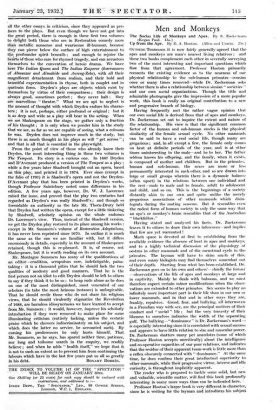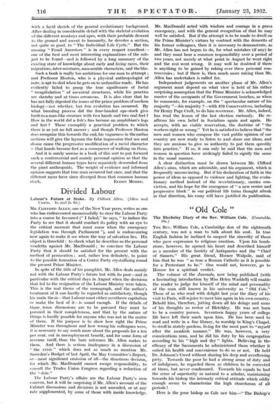Men and Monkeys
The Sodas Life of Monkeys and Apes. By S. Zuckennen. (Kegan Paul. 15e.)
Up from the Ape. By E. A. Heaton. (Allen and Unwin. 25s. ) OUTSIDE Tennessee it is now fairly generally agreed that the apes and monkeys are man's nearest living relatives ; and these two books complement each other in severally surveying two of the most interesting and important questions which flow from that agreement. Professor Hooton primarily recounts the existing evidence as to the nearness of our physical relationship to the sub-human primates—cousins once or many times removed—while Dr. Zuckerman asks whether there is also a relationship between simian " societies and our own social organizations. Though the title and admirable photographs give the impression of a more popular work, this book is really an original contribution to a new and progressive branch of biology.
Having frequently met the rather vague opinion that our own social life is derived from that of apes and monkeys, Dr. Zuckerman set out to inquire the extent and nature of the relationship. His view is that the significant common factor of the human and sub-human stocks is the physical similarity of the female sexual cycle. No other mammals can be said to have a real social life, though many are gregarious ; and, in all except a few, the female only comes on heat at definite periods of the year, and is at other times uninteresting to the male—and he to her. The father seldom knows his offspring, and the family, when it exists, is composed of mother and children. But in the primates, human and sub-human, the sexes are more or less permanently interested in each other, and so are drawn into large or small groups wherein there is a dynamic balance (often upset) in the relations between one individual and the rest—male to male and to female, adult to adolescent and child, and so on. This is the beginnings of a society distantly akin to our own and quite unlike the merely gregarious associations of other mammals which disin- tegrate during the mating seasons. But it resembles even the rudest form of human society in only the same way that an ape's or monkey's brain resembles that of the Australian " blackfellow."
Having stated and analysed his facts, Dr. Zuckerman leaves it to others to draw their own inferences--and implies that few are yet warranted !
Much space is devoted at first to establishing from the available evidence the absence of heat in apes and monkeys, and to a highly technical discussion of the physiology of oestrus in other mammals and of the menstrual cycle in the primates. The layman will have to skim much of this, and even many biologists may find themselves somewhat out of their depth. Starting from what has been established, Dr. Zuckerman goes on to his own and others'—chiefly the former —observations of the life of apes and monkeys at large and in captivity. Mainly he deals with baboons, and we must therefore expect certain minor modifications when the obser- vations are extended to other primates. Sex seems to play an infinitely more important part in their life than in our own or lower mammals, and in that and in other ways they are, frankly, repulsive. Greed, fear, and bullying, all interwoven in a Freudian way with sex, arc the principal motives of their conduct and " social " life ; but the very travesty of their likeness to ourselves indicates the width of the separating gulf. The bullying—" dominance" is Dr. Zackerman's word— is especially interesting since it is correlated with Sexual success and appears to have little relation to site and muscular power. Dr. Zuckerman shatters many pet anecdotes (some of which Professor Hooton accepts uncritically) about the intelligence and co-operative capacities of our poor relations, and indicates that the residue of their apparent team-work is little more than a reflex obscurely connected with " dominance." At the same tirae, he does confirm their great intellectual superiority to other mammals, while their progressive virtue, intense and idle curiosity, is throughout implicitly apparent. The reader who is prepared to tackle some solid, but new and valuable; scientific matter, will find this book profoundly interesting in many more ways than can be indicated here.
Professor Hooton's larger book is very different in cluvaeter, since he is writing for the layman and introduces' his subject
with a lucid sketch of the general evolutionary background. After dealing in considerable detail with the skeletal evolution of the different monkeys and apes, with their probable descent to the ground and ascent to humanity, he devotes a section, not quite so good, to " The Individual Life Cycle." But the ensuing " Fossil Ancestors " is in every respect excellent— one of the hest and most interesting explanations of the sub- ject to be found—and is followed by a long summary of the .existing state of knowledge about early and living races, their migmtions,inter-mixtures, measurable characters, and the like.
Such a book is really too ambitious for one man to attempt ; and Professor Hooton, who is a physical anthropologist of note, is apt to skid when he gets on to unfamiliar roads. He has evidently failed to grasp the true significance of foetal " recapitulation " of ancestral structures, while his genetics are sketchy and at times erroneous. It is also clear that he has not fully digested the issues of the prime problem of modern biology—not whether, but how evolution has occurred. By what breeding process did the four-handed ape-stock give birth to a man-like creature with two hands and two real feet ? How in the world did a fish's fins become an amphibian's legs and feet ? These exemplify a genetical problem to which there is as yet no full answer ; and though Professor Hooton does recognize this towards the end, his vagueness in the earlier sections will give the layman the false impression that use and disuse cause the progressive modification of a racial character —that hands become feet as a consequence of walking on them.
And it is surely unwise in a book of this sort to put forward such a controversial and mainly personal opinion as that the several different human types have separately descended from the giant anthropoids. The weight of evidence and informed opinion suggests that true man occurred but once, and that the different races have since diverged from that common human





































 Previous page
Previous page